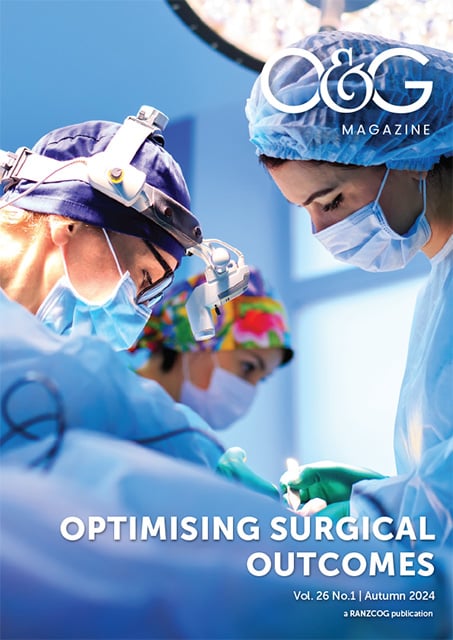Transgender patients may desire surgical intervention as part of their gender journeys to align their body with how they feel it is supposed to be. Such a request is medically necessary and should be offered.
The Standards of Care, version 8, by the World Professional Association for Transgender Health (WPATH), has constituted criteria for various gender-affirming surgeries1. Surgeries available include chest or breast surgery (top surgery), genital surgery (bottom or lower surgery), facial surgery and other surgeries.
Besides a hysterectomy, patients may request a vaginectomy, or a phalloplasty or metoidioplasty. Gynaecologists may encounter patients returning from another state or country who request post-operative care after vaginoplasty or vulvoplasty. It is beneficial to become familiar with the surgical technique, anatomic alterations, impact on sexuality, general post-operative care, and common complications of these surgeries2.

Key considerations for treating transgender patients
WPATH recommends one assessment from a mental health professional, some surgeons or insurance companies require two assessments, as well as one from the physician that prescribes gender-affirming hormones to the patient. This may vary between countries. The assessments ensure mental stability and a support system. Persistent gender dysphoria and the ability to give informed consent are required. A person must be on hormone treatment for a year unless clinically not indicated (for non-binary persons).
Social transition (appearance or expression as clothing or hairstyles) is not required for a hysterectomy.
Transmasculine patients may request a hysterectomy for gender affirmation as a prerequisite for legal transition, a desire to avoid future gynaecological examinations or complications, and/or for conditions such as endometriosis, ovarian cysts, pelvic pain, dysmenorrhea, or menorrhagia. Combined chest reconstruction and hysterectomy can be considered.
There are no standard guidelines for pre-operative care for transmasculine people on testosterone therapy. During pre-operative visits, the doctor and patient should discuss the risks, benefits, alternatives (informed consent) and the mode of hysterectomy; laparoscopic (robotic) versus a vaginal approach. Consider a salpingectomy at the time of hysterectomy and discuss the risks and benefits of an oophorectomy (based on desired fertility, current age, impact on bone density, cardiovascular and cognitive impact, ovarian cancer risk, and possible need for future gynaecological procedures due to cysts, torsion, ovarian cancer). Future fertility must be discussed, and information offered on egg or embryo cryopreservation. Preventive care after surgery may include CST If the patient has a history of cervical dysplasia, and abdominal ultrasound or a pelvic exam if ovaries stay in situ, as well as a chest exam after a mastectomy, since not all breast tissue is removed.
Other important things to consider
Pre-operative testing includes performing CST, evaluation and optimisation of blood pressure, lipid profile, haematocrit levels, diabetes and thyroid screening if indicated (many transmasculine patients have PCOS, hyperinsulinemia, metabolic syndrome, elevated haematocrit (secondary polycythaemia) and obstructive sleep apnoea associated with testosterone therapy). Secondary polycythaemia by itself does not increase thrombosis risk. Obtain an STD panel if indicated. Smoking and visceral fat distribution can impact ventilation when a patient is in Trendelenburg position during minimally invasive surgery.
It’s important to discuss the patient’s nutrition status as many transgender patients are neurodivergent and/or struggle with eating disorders, restrictive eating or have a diet rich in fat, salt, and carbohydrates and poor protein and vitamin intake. Also ask about alcohol intake and other substance use and check what medications and supplements the patient is taking and stop NSAIDS and other anti-platelet agents at least a week prior to surgery. The patient can continue testosterone therapy and does not need to stop it prior to surgery; this can initiate reoccurrence of the menstrual cycle which increases gender dysphoria.
Standard antibiotic prophylaxis for a hysterectomy is recommended, a first-generation cephalosporin, if allergic clindamycin, erythromycin or metronidazole3. A typical regimen would be Metronidazole 500mg po bd the day prior to surgery, and Cefazolin 1-3 gram with Metronidazole 500mg iv during surgery to treat potential bacterial vaginosis, which is more prevalent in transgender men due to a change in vaginal microbiome on testosterone4.
Patients on testosterone therapy require vaginal oestradiol cream of 1 gram three times a week for two-four weeks before, and up to three months post-surgery, which changes the vaginal microbiome5, decreases BV risk6, decreases cuff cellulitis and the risk of cuff dehiscence. Penetrative sexual activity should be avoided for 8-12 weeks. Suture choice, closing the cuff in one or two layers does not seem to impact the incidence of cuff dehiscence7.
Low dose estradiol vaginal cream maintenance for patients on testosterone therapy is recommended, especially after an oophorectomy, as many develop genitourinary syndrome8,9. Use of this cream does not appear to affect masculinisation.
Consider thrombosis prophylaxis (compression boots during surgery), accelerated ambulation and same-day discharge. Schedule the patient for surgery early in the day to help avoid nausea prophylaxis and remove the IDC in the operating room prior to taking the patient to recovery and commence regular diet early. Discharging the patient on the same day prevents admission to the gynaecology ward with cisgender women (consider admitting the patient to the surgery ward if staff familiar with post-operative care after having a hysterectomy and if they have had gender-affirming sensitivity training).

Gender-affirming sensitivity training
It is important that staff at the hospital or surgical centre, have received gender-affirming sensitivity training and are aware that the patient receiving surgery is transgender. This can help ensure appropriate name and pronouns are used by everyone (especially if they have not changed their name and gender marker legally and therefore the medical record does not match the chosen name and pronouns.) Make sure everyone involved in the patient’s care is aware of the type of surgery that is going to be performed.
Allow the patient to use the bathroom of their choice. Also ask them if the person who accompanies them to the hospital is safe to talk to after surgery about their surgery and transgender status. Never “out” a transgender patient. Ask for preferred terminology of body parts (front canal instead of vagina) and take an “anatomy inventory”.
About Dr Luikenaar
Rixt Luikenaar is an Obstetrician-Gynaecologist, who owns Rebirth Health Center, a private practice focused on gynaecology and transgender and gender-expansive care in Salt Lake City, UT. Dr Luikenaar graduated Medical School Cum Laude, from the University of Groningen, The Netherlands, and is Adjunct Faculty at the University of Utah. In 2010, they spent a sabbatical in Cairns, Australia, as a Senior Medical Officer with Dr Paul Howat. Dr Luikenaar has treated over 7,000 transgender patients with gender-affirming hormone therapy since 2011 and has performed hundreds of hysterectomies and orchiectomies for transgender patients. They trained with several surgeons in the United States to learn vaginoplasty and co-edited and co-authored Transgynecology, a textbook published in 2023 by Cambridge University Press10.
References
- WPATH Standards of Care Version 8, https://www.wpath.org/soc8
- Gender Affirmation, medical and surgical perspectives, Christopher J. Salgado, Stan J. Monstrey, Miroslav L. Djordjevic. Thieme Medical Publishers; New York, 2017.
- Comprehensive Care of the Transgender Patient, Cecile A. Ferrando. Elsevier; 2020.
- Winston McPherson G, Long T, Salipante SJ, Rongitsch JA, Hoffman NG, Stephens K, Penewit K, Greene DN. The Vaginal Microbiome of Transgender Men. Clin Chem. 2019 Jan;65(1):199-207. doi: 10.1373/clinchem.2018.293654. PMID: 30602481.
- Graver, M. A., Wade, J. J. (2011). The Role of Acidification in the Inhibition of Neisseria Gonorrhoeae by Vaginal Lactobacilli During Anaerobic Growth. Clin. Microbiol. Antimicrob. 10, 8. doi: 10.1186/1476-0711-10-8
- Soper D. E. Bacterial vaginosis and postoperative infections. The American Journal of Obstetrics and Gynecology. 1993;169(2):467– doi: 10.1016/0002-9378(93)90343-h
- Lian Elfering, Tim C. van de Grift, Mark-Bram Bouman, Norah M. van Mello, Freek A. Groenman, Judith A. Huirne, Ivo Y. W. Budiman, Linde D. J. Goijen, Dorothea K. G. van Loenen & Margriet G. Mullender (2020) Combining total laparoscopic hysterectomy and bilateral salpingo-oophorectomy with subcutaneous mastectomy in trans men: The effect on safety outcomes, International Journal of Transgender Health, 21:2, 138-146
- Grynberg M, Fanchin R, Dubost G, Colau JC, Brémont-Weil C, Frydman R, Ayoubi JM. Histology of genital tract and breast tissue after long-term testosterone administration in a female-to-male transsexual population. Reprod Biomed Online. 2010 Apr;20(4):553
- The Effect of Gender-Affirming Medical Care on the Vaginal and Neovaginal Microbiomes of Transgender and Gender Diverse people. Yohan Krakowsky, Emery Potter, Jason Hallarn, et al. Frontiers in cellular and infection Microbiology. January 21, 2022.
- van Trotsenburg M, Luikenaar RAC, Meriggiola MC, eds. Context, Principles and Practice of TransGynecology: Managing Transgender Patients in ObGyn Practice. Cambridge University Press; 2022






Leave a Reply